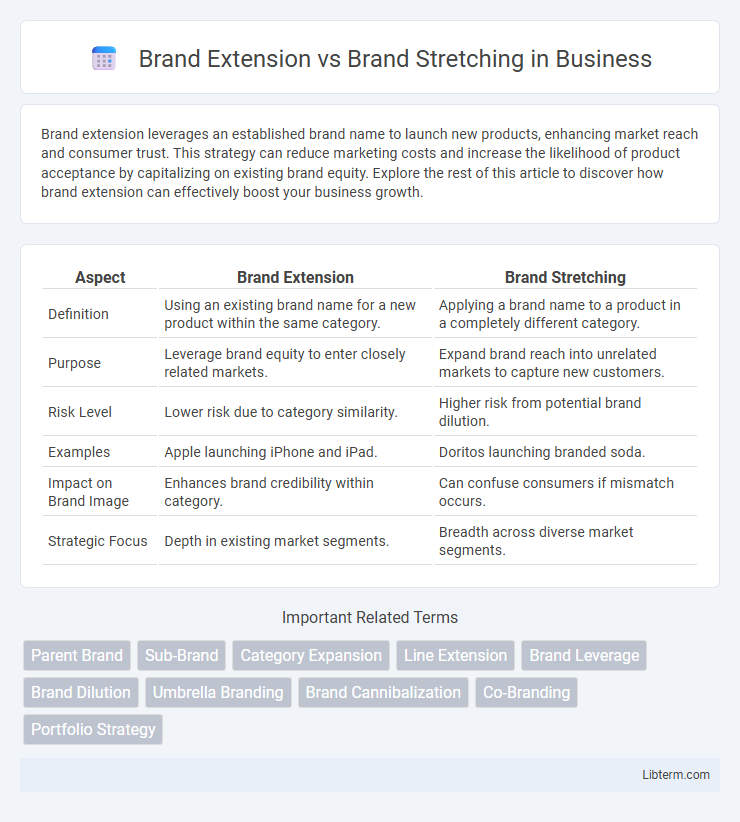Brand extension leverages an established brand name to launch new products, enhancing market reach and consumer trust. This strategy can reduce marketing costs and increase the likelihood of product acceptance by capitalizing on existing brand equity. Explore the rest of this article to discover how brand extension can effectively boost your business growth.
Table of Comparison
| Aspect | Brand Extension | Brand Stretching |
|---|---|---|
| Definition | Using an existing brand name for a new product within the same category. | Applying a brand name to a product in a completely different category. |
| Purpose | Leverage brand equity to enter closely related markets. | Expand brand reach into unrelated markets to capture new customers. |
| Risk Level | Lower risk due to category similarity. | Higher risk from potential brand dilution. |
| Examples | Apple launching iPhone and iPad. | Doritos launching branded soda. |
| Impact on Brand Image | Enhances brand credibility within category. | Can confuse consumers if mismatch occurs. |
| Strategic Focus | Depth in existing market segments. | Breadth across diverse market segments. |
Understanding Brand Extension: Definition and Key Concepts
Brand extension refers to leveraging an existing brand name to launch new products within the same or closely related categories, enhancing brand equity and reducing market entry risks. Key concepts include maintaining brand consistency, aligning with core brand values, and ensuring product relevance to meet customer expectations. Effective brand extension strengthens consumer trust and expands market reach without diluting the original brand identity.
What is Brand Stretching? Core Principles Explained
Brand stretching refers to leveraging an established brand name to enter a new product category that differs significantly from the original market, aiming to capitalize on existing brand equity while minimizing market entry risks. Core principles include maintaining brand consistency to avoid consumer confusion, ensuring relevance by aligning new products with brand values, and preserving perceived quality to protect brand reputation. Successful brand stretching balances innovation and credibility, fostering customer trust across diversified offerings.
Differences Between Brand Extension and Brand Stretching
Brand extension involves leveraging an established brand name to introduce new products within the same category or closely related markets, ensuring brand relevance and consumer trust. Brand stretching, however, refers to using the brand name to enter entirely different product categories, often risking brand dilution due to lack of fit. The primary difference lies in the strategic scope: brand extension maintains category consistency, while brand stretching ventures into new and unrelated markets.
Benefits of Brand Extension for Companies
Brand extension enables companies to leverage existing brand equity to enter new product categories, reducing marketing costs and increasing consumer trust. It enhances brand visibility and accelerates acceptance of new products by capitalizing on established brand loyalty. This strategy also minimizes the risks associated with launching entirely new brands, facilitating faster market penetration and revenue growth.
Risks and Challenges in Brand Stretching
Brand stretching carries significant risks including brand dilution, where extending a brand into unrelated product categories weakens its original identity and reduces customer loyalty. Challenges include consumer confusion, potential negative impact on brand equity, and difficulty maintaining consistent quality and messaging across diverse product lines. Failure to align the new products with core brand values can lead to market rejection and financial losses.
Successful Examples of Brand Extension
Successful brand extensions leverage the original brand's equity to enter new product categories while maintaining consumer trust, as seen with Apple expanding from computers to smartphones and wearables. These extensions benefit from strong brand recognition and customer loyalty, driving initial sales and facilitating market acceptance, unlike brand stretching which risks diluting brand identity by venturing into unrelated markets. Effective brand extensions increase market share and enhance brand value by aligning with core brand attributes and consumer expectations.
Notable Cases of Brand Stretching Gone Wrong
Brand stretching often fails when a brand ventures too far from its core identity, as seen with Colgate's launch of frozen food, which confused consumers and damaged brand credibility. Another notable case is Harley-Davidson's perfume line that diluted the rugged motorcycle brand image, resulting in poor market reception. These examples highlight the risks of brand stretching when the new product category lacks a logical connection to the original brand promise.
Market Research: When to Choose Extension vs. Stretching
Market research reveals that brand extension is ideal when existing brand equity aligns closely with new product categories, reducing consumer risk perception and boosting adoption rates. Brand stretching suits scenarios where consumer insights indicate strong brand loyalty but gaps in category relevance require innovation to enter distinct markets. Analyzing customer demographics, competitor positioning, and brand associations helps determine whether to leverage familiar attributes through extension or diversify boldly with stretching.
Consumer Perceptions: Impact on Brand Equity
Brand extension typically enhances consumer perceptions by leveraging existing brand equity, fostering trust and acceptance when new products align with the core brand identity. In contrast, brand stretching risks diluting brand equity if consumers perceive the new offerings as inconsistent or incongruent with the brand's established image. Maintaining relevance and coherence between the original brand and extension is crucial for preserving consumer loyalty and positive brand associations.
Strategic Guidelines for Effective Brand Leveraging
Effective brand leveraging requires clear differentiation between brand extension and brand stretching to maintain brand equity. Brand extension involves using an existing brand name for a new product within the same category, ensuring relevance and customer trust, while brand stretching often crosses into unrelated categories and risks diluting brand identity. Strategic guidelines emphasize alignment with core brand values, careful market research to assess fit and consumer perception, and maintaining consistency in quality and messaging to enhance brand equity and drive growth.
Brand Extension Infographic

 libterm.com
libterm.com